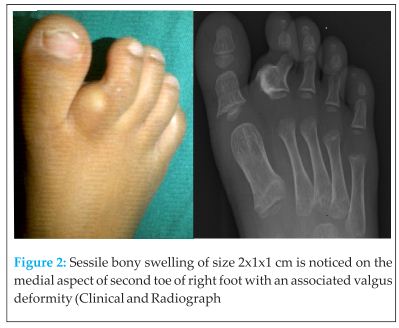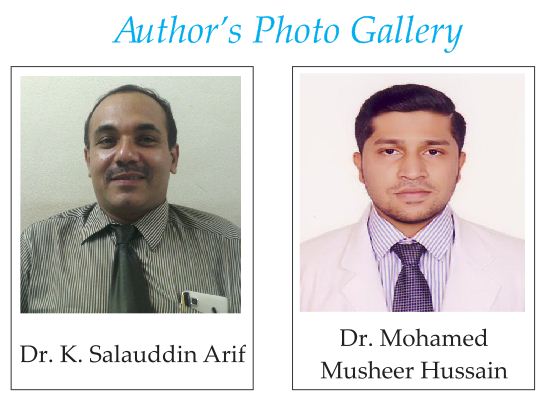[box type=”bio”] What to Learn from this Article?[/box]
Bizarre osteochondromatous proliferation is an entity that can rarely be the cause of anguar deformities in children.
Case Report | Volume 5 | Issue 1 | JOCR Jan-March 2015 | Page 45-47 | Mohamed Musheer Hussain, K. Salauddin Arif. DOI: 10.13107/jocr.2250-0685.253
Authors: Mohamed Musheer Hussain[1], K. Salauddin Arif[1]
[1] Department of Orthopaedics, Yenepoya Medical College, Mangalore, Karnataka, India –575018.
Address of Correspondence:
Dr. M. Musheer Hussain, Room No. 511, Gardenia mens hotesl, Yenepoya university, laxmigudde, derlakkatte, Mangalore – 575018. India. Email: mushyhuz@gmail.com
Abstract
Introduction: There have been fewer than 150 cases of Bizarre Parosteal Osteochondromatous proliferation (Nora Lesions) reported in the literature to date and no significant reports on angular deformities caused by this lesion. Nora’s lesion can easily be misdiagnosed as osteochondroma or chondrosarcoma and therefore inappropriately managed. Although this condition classically appears in the second or third decade, we present to you a three year old boy who presented with multiple bony swellings over the hand and feet that caused an angular deformity of the involved digits. In the case report we have detailed the angular deformities and its treatment outcome.
Case Report: A three year old boy presented with valgus deformity of middle finger of right upper limb with an associated ulnar bony swelling at the level of middle phalanx which was noticed two years before and was progressing rapidly since last three months. On physical examination the swellings were found to be bony hard, midly tender and found to have been causing an angulare deformity of the digits. The initial suspicion was of osteochondromatous lesion however the excision biopsy showed the lesion to be of the rare entity of bizarre parosteal osteochondromatous proliferation. 1 year follow up showed no progression of angular deformity of the operated digits.
Conclusion: Bizarre osteochondromatous proliferation is an entity that can rarely present in children which needs to be identified and tackled early to prevent the onset of deformities. Almost all cases warrant surgical intervention and the type of excision varies with the type of lesion.
Keywords: BPOP, Bizarre parosteal osteochondromatous proliferation, Osteochondroma, Nora Lesion.
Introduction
Bizzare parosteal osteochondromatous proliferation (BPOP) is also called Nora’s lesion [1], who was the pathologist who described it in 1983. It is a benign lesion typically affecting hands and feet [1-4]. It has no sex predilection [5]. Typical age group affected is from 2nd to 6th decade. It is very rarely seen below the age of 5years.
The most common differential diagnosis for BPOP is osteochondroma. BPOP is a distinct entity from osteochondroma both clinically and histopathologically[5,6,7]. As compared to osteochondroma, BPOP has higher recurrence rates after excision suggesting it is aggressive in nature [1,4,7]. As far as we know, there is no published evidence of BPOP causing angular deformity. BPOP can cause significant angular deformities especially when it occurs in very young age, as shown in this case report.
Case report
We present a three year old boy with valgus deformity of middle finger of right upper limb with an associated ulnar bony swelling at the level of middle phalanx which was noticed two years before and was progressing rapidly since last three months. On physical examination a pedunculated bony swelling was noticed to be arising from dorsoulnar aspect of the base of the middle phalanx measuring 2x1x3 cm (Fig 1). Another sessile bony swelling of size 2x1x1 cm is noticed on the medial aspect of second toe of right foot with an associated valgus deformity (Fig 2). Mild tenderness was present in both the lesions.
Radiographs of the right hand showed a pedunculated mass arising from the proximal metaphysio-diaphyseal junction of middle phalanx (Fig 1). 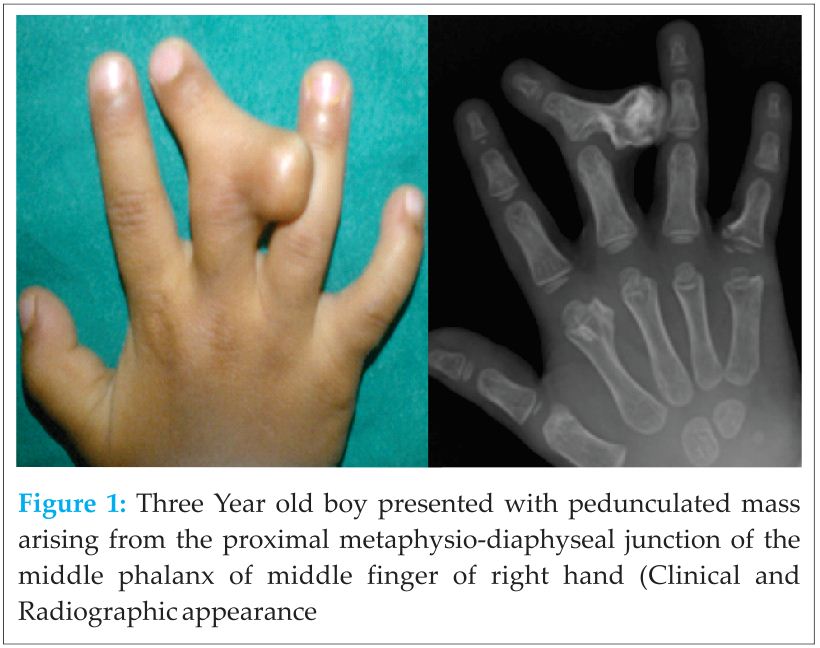
Indications for surgery were progressive angular deformity, increasing size and pain. As the lesion in the hand was pedunculated, marginal excision biopsy could be performed. The lesion in the foot was sessile and hence wide excision was done (excision of the proximal half of the affected phalanx.)
Resected specimen consisted of thin cartilage cap and bone tissue. Histologically the lesion had three components: fibroblastic spindle cells, cartilage with mild cellular atypia and irregular bony trabeculae, all present in intermixed islands without any specific pattern (Fig 3).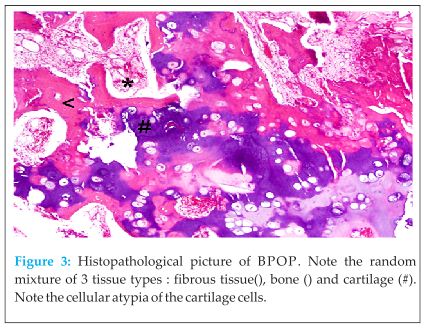
Latest follow up at one year since index surgery showed no recurrence. There was partial correction of the deformities of the operated phalanges. Also, some of the lesions which were initially found on skeletal survey to be small, have grown in size causing similar deformity of the affected phalanges, which might need future surgical intervention.
Discussion
Osteochondroma is the most important differential diagnosis for BPOP (Table 1).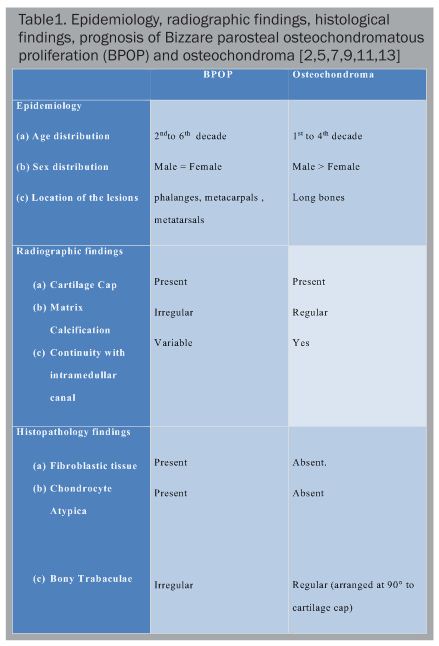
The type of excision to be done is an important issue for the obvious reason that the recurrence is high [1,4,7,11]. Unfortunately, it is very vaguely described in literature. Terms like excision, simple excision are used instead of standard terms like intralesional excision (curettage), marginal excision or wide excision [4]. Intralesional excision is associated with higher recurrence rate and hence not recommended [12,13,14]. In our opinion either marginal or wide excision is essential. There are two important factors to be considered in decision-making, one, location of the lesion location whether in toes or fingers; two, presence or absence of peduncle. In pedunculated lesions, marginal excision can be performed without affecting the function of the finger or toe. In case of sessile lesions the level of excision is not easy to decide. Because of the functional deficit that occurs in proportion to the extent of excision performed, our advice is to do marginal excision in the fingers and partial phalanx excision (equivalent to wide excision) in the toes. However, it should be kept in mind that should the tumor recur after marginal excision, wide excision with or without arthrodesis is required during the revision surgery.
Informed followup is essential for atleast three reasons. One, new lesions appear frequently in the same or other digits. Second, higher recurrence rates after surgery compared to osteochondroma. Third, corrective osteotomy may be needed at a later date after the excison, if the angular deformity does not get corrected by itself.
Conclusion
Bizarre osteochondromatous proliferation is an entity that can rarely present in children which needs to be identified and tackled early to prevent the onset of deformities. Almost all cases warrant surgical intervention and the type of excision varies with the type of lesion.
Clinical Message
The incidence of bizarre parosteal osteochondromatosis is rare in paediatric age group and this occurrence leads to the development of angular deformities in the developing bone. Early diagnosis and intervention can prevent further progession of the deformity.
References
1.Nora FE, Dahlin DC, Beabout JW. Bizarre parosteal osteochondromatous proliferations of the hands and feet. Am J Surg Pathol. 1983;7(3):245-50.
2.Abramovici L, Steiner GC. Bizarre parosteal osteochondromatous proliferation (Nora’s lesion): a retrospective study of 12 cases, 2 arising in long bones. Hum Pathol. 2002;33(12):1205-10.
3.Soon JL, Chang HC, Sim CS, et al. A case of Bizarre Parosteal Osteochondromatous Proliferation of the hand. Singapore Med J. 2003;44(1):27-30.
4.Meneses MF, Unni KK, Swee RG. Bizzare parosteal osteochondromatous proliferation of bone (Nora’s lesion). Am J Surg Pathol. 1993;17(7):691-97.
5.Horiguchi H, Sakane M, Matsui M, et al. Bizzare parosteal osteochondromatous proliferation (Nora’s lesion) of the foot. Pathol Int. 2001;51(10):816-23.
6.Gerald Gruber,Christian Giessauf, Andreas Leithner, et al. Bizarre parosteal osteochondromatous proliferation (Nora lesion): a report of 3 cases and a review of the literature. Can J Surg.2008;51(6):486–89.
7. Dhondt E, Oudenhoven L, Khan S, et al. Nora’s lesion, a distinct radiological entity? Skeletal Radiol. 2006;35(7):497-502.
8.Sundaram M, Wang L, Rotman M, Howard R, et al. Florid reactive periostitis and bizarre parosteal osteochondromatous proliferation: pre-biopsy imaging evolution, treatment and outcome. Skeletal Radiol. 2001;30(4):192-98.
9. E.W. Brien, C.A. Zahiri, J.M. Mirra. Florid reactive periostitis ossificans of the proximal aspect of the tibia: a lesion that must be distinguished from osteosarcoma. J Bone Joint Surg 1999;81A(7): 1002–07.
10.William C. Torreggiani, Peter LM, Khalid Al-Ismail. MR imaging features of bizarre parosteal osteochondromatous proliferation of bone (Nora’s lesion) Eur J Radiol 2001;40(3):224-31.
11.Michelsen H, Abramovici L, Steiner G, Posner MA. Bizarre parosteal osteochondromatous proliferation (Nora’s Lesion) in the hand. J Hand Surg 2004;29:520-25.
12.Suresh SS. Nora’s lesion of the second toe. Indian J Orthop 2010;44(3):342-44.
13.Rybak LD, Abramovici L, Kenan S, et al. Cortico-medullary continuity in bizarre parosteal osteochondromatous proliferation mimicking osteochondroma on imaging. Skeletal Radiol. 2007;36(9):829–34.
14. S. Chaabane, M. Chelli Bouaziz, K. H. Ben Ghars et al. Bizarre Parosteal Osteochondromatous Proliferation: Nora’s Lesion. Iran J Radiol 2011;8(2):119–25.
| How to Cite This Article: Hussain MM, Salauddin AK. Bizarre Parosteal Osteochondromatous Proliferation causing angular deformities: A Case Report. Journal of Orthopaedic Case Reports 2015 Jan-March;5(1): 45-47. Available from: https://www.jocr.co.in/wp/2015/01/28/2250-0685-253-fulltext/ |
[Full Text HTML] [Full Text PDF] [XML]
[rate_this_page]
Dear Reader, We are very excited about New Features in JOCR. Please do let us know what you think by Clicking on the Sliding “Feedback Form” button on the <<< left of the page or sending a mail to us at editor.jocr@gmail.com

